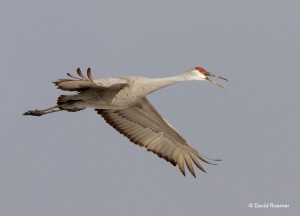Sandhill Crane
Lesser Sandhill Crane (Grus Canadensis Canadensis)
Photo by David Roemer
The body plumage of Lesser sandhill cranes is a gradient of grays but its forehead and crown are covered with a reddish skin. Adults exhibit a white cheek patch that interrupts the pale gray face, chin, upper throat, and nape. Legs and toes are black. Sandhill cranes’ 5 1/2 to 7 ½ feet wingspan allows them to soar on thermals, saving energy on long migratory flights.
People in Kansas are very familiar with Nebraska’s Platte River that attracts 450,000 Sandhill cranes in the spring preparing for their long journey north to breeding grounds in the boreal forests of Canada and Alaska. However, if you missed them in the spring, you can also observe them (albeit in smaller numbers) during their fall migration. A smaller number of Sandhill cranes stop in Nebraska while migrating south than visited during their northern migration. Instead, as many as 48,000 birds stop at the Quivira National Wildlife Refuge in central Kansas between October 8th and late November. The Salt Plains National Wildlife Refuge in Oklahoma may attract as many as 25,000 birds. From here they will continue to their final winter destinations in Arizona, New Mexico, Texas and northern Mexico completing a 4,000 mile journey that began in Siberia and Alaska, mostly by the collective memories of the flock.
Habitat: Sandhill cranes require freshwater wetlands, such as marshes, wet grasslands and river basins. They breed mostly in open sedge meadows in wetlands that are contiguous to uplands with short vegetation.
Predators: Mammalian predators: foxes, raccoons, coyotes, wolves, bobcats and lynx. Aerial predators: eagles, large owls and Peregrin falcons. Sandhill cranes jump into the air and kick when defending themselves from aerial predators. Land predators can be stabbed with a crane’s bill with enough power to penetrate its skull. But in Alaska different predators are threats: golden eagles and arctic foxes.
Diet: Sandhill Cranes are generalists that feed on planted agricultural seeds such as corn, tubers, grains, mice, snakes, insects and worms.
Dancing: Sandhill cranes engage in exuberant dancing (jumping, running, and wing flapping) especially during courtship. This includes a variety of neck positions and vocalizations. These calls can be heard at https://www.savingcranes.org/sandhill-crane.html

